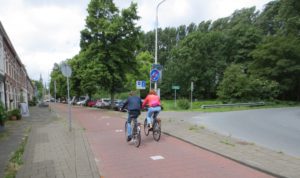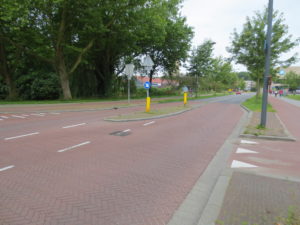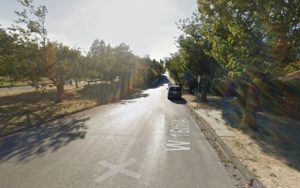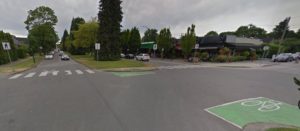Retrofitting for Protected Bike Lanes in de Nederlands
In Delft, we have been looking at streets which have been converted from streets with bike lanes to cycle tracks (otherwise known as protected bike lanes). Both Delfgauwseweg and Ruys de Beerenbrouckstraat have received this treatment.
On Delfgauwseweg, the street has been converted to a two-way cycle track on the west side of the street. Although there are connections to local roads on this side of the street compared to the canal side, the cycle track is not on the canal side to reduce the number of times the cycle track needs to cross the busy Delfgauwseweg. The canal also reduces the amount of room available to install cycle tracks.
On Ruys de Beerenbrouckstraat, the road received a treatment that included the installation of a pair of one-way cycle track in addition to other treatments I mentioned in an earlier blog. This was chosen because bikes may be entering the street from either side, there was room to add a cycle track on each side and there are also locations that cyclists may want to visit on either side. This was done in conjunction with other treatments for those traveling by foot or bike, such as adding additional raised crossing.
In Vancouver, this treatment could be used West 16th avenue, an east-west route, between Trafalgar Street and Blanca Street. It would provide a connection with the “highway” bike path on the Ministry of Transportation controlled section of 16th leading to UBC. A median divides the street and it some parts acting as a barrier to significant elevation changes between cars travelling east and west. Aside from that, the median serves only aesthetic purposes.
The streets are around 7.6 metre (24.9 feet wide). Parking is usually allowed often allow parking that is rarely used, except around schools. Additionally, there is a 3.5 metre (10.3 feet) grass buffer between the sidewalk and the roadway. The median could also be reduced.
I would recommend a pair of one-way cycle tracks on this area because it is a direct and relatively low-volume main east-west route. There are already sharrows and bike lanes sporadically along the route, but the wide boulevard encourages speeding. Although the road is wide, cars tend to travel in the centre of the lane forcing bikes into the door zone of parked cars. There is ample space for a cycle track on each side even if parking is left on both sides.
This route is an important connection to a preschool, two elementary school and high school directly on the route and many others are near the route. Many UBC students use the route as well. Even as it currently is, many grade-school students ride on the sidewalks showing a need as well as potential growth for the cycle track. Additionally, frequent left-turns and large hills increase potential conflict between vehicles and bikes.
Adding a cycle track would be relatively cheap and convenient for this street. Even without using any of the buffer or median, one lane can be broken down into a 10 feet lane and 7 foot parking spot leaving exactly 7.9 feet to add the 5 feet one-way cycle track and 2.9 foot buffer. This means that cycle tracks can be added immediately using only paint and temporary buffers along most of the route. One-way cycle tracks are preferable because there the street widths allow for split the cycle track directions and to better connect with other routes. There are also already ample crossings near amenities from previous street calming that could be upgraded for bikes preventing cyclists from traveling significant distances before crossing the road.
In phase two of improvements, additional treatments such as those done along Ruys de Beerenbrouckstraat could improve pedestrian facilities. Adding the cycling track will narrow the amount of space that cyclists need to cross and discourage speeding after leaving the highway (a change from 70 km/h to 50 km/h). Raised crossings would also decrease speeding and increase safety perception for those crossing. All of these treatments would increase visibility which is especially important for younger crosswalk users.
Making this route safer for users traveling by bike at crossings, along hills and beside schools would create new strong connections. Although a complete network for Vancouver should be a priority, routes like this one are also very valuable.



